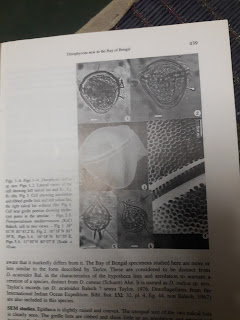Ceratium hirundinella
It is a fresh water dinoflagellate generally seen in oligotrphic waters. Oligotrophic waters are very rare and they are unpolluted without minerals or less minerals.
These are indicator organisms for pollution free waters.
Eutrophic waters are common but they are polluted.
There are very few oligotrophic lakes in India. One is amidst a forest in Maharastra and another is at Kodaikanal - Berigium Lake ,Berigium forest range under the control of forest dept. Even Dal and Manasarovar Lake is polluted.
The organism Ceratium a genus that is a very common genus in marine and freshwater bodies. They develop apical and antapical horns , here three antapical horns and one apical horn. The formation of horns is an adaptive feature of the organism against predators.
It is an autotrohic organism evidenced by the green colour it shows because many dinoflagellates are heterotrophic and show animal like features.
It is a fresh water dinoflagellate generally seen in oligotrphic waters. Oligotrophic waters are very rare and they are unpolluted without minerals or less minerals.
These are indicator organisms for pollution free waters.
Eutrophic waters are common but they are polluted.
There are very few oligotrophic lakes in India. One is amidst a forest in Maharastra and another is at Kodaikanal - Berigium Lake ,Berigium forest range under the control of forest dept. Even Dal and Manasarovar Lake is polluted.
The organism Ceratium a genus that is a very common genus in marine and freshwater bodies. They develop apical and antapical horns , here three antapical horns and one apical horn. The formation of horns is an adaptive feature of the organism against predators.
It is an autotrohic organism evidenced by the green colour it shows because many dinoflagellates are heterotrophic and show animal like features.



Comments
Post a Comment